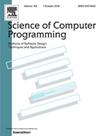设计模型修复的自动化
IF 1.4
4区 计算机科学
Q3 COMPUTER SCIENCE, SOFTWARE ENGINEERING
引用次数: 0
摘要
设计模型是实际过程或软件产品的抽象表示。虽然在实现之前可以通过诊断设计模型来发现一些软件故障,但修复设计模型对于软件开发人员来说是非常耗时的。为了实现更快的软件开发,本文介绍了一种通过模型检查诊断出的设计模型的自动修复方法。模型检查器用于检测设计模型中的错误,例如无法到达的目标和违反的属性。通过约束求解和预测模型找到插入、修改和删除算子,并行地消除这些故障。模型修复的结果使用ISO/IEC 25010软件质量指标进行评估。实验结果表明,该方法可以在保证模型质量的前提下消除各种设计模型中的不可达目标和不变性违例。设计模型修复过程的有效性和性能主要取决于设计模型的复杂性、约束求解器的效率和预测模型的准确性。该研究表明,模型驱动软件开发可以通过模型诊断、故障排除和质量评估的自动化来提高开发效率。本文章由计算机程序翻译,如有差异,请以英文原文为准。
The automation of design model repair
A design model is the abstract representation of an actual process or software product. Although some software faults can be found by diagnosing design models before implementation, repairing the design models is time-consuming to software developers. To achieve faster software development, this paper introduces an automated approach to generally repair design models diagnosed by model checking. Model checkers are used to detect faults such as unreachable goals and violated properties in design models. Such faults are eliminated in parallel by insertion, modification and deletion operators found by constraint solving and predictive models. The outcomes of model repair are evaluated using the ISO/IEC 25010 software quality metrics. Experimental results have demonstrated that the proposed approach can eliminate unreachable goals and invariant violations in various design models while preserving their model quality. The effectiveness and performance of such design model repair processes depend mainly on the complexity of design model, the efficiency of constraint solver and the accuracy of predictive model. This study indicates that model-driven software development can be more efficient by automating model diagnosis, fault elimination and quality evaluation.
求助全文
通过发布文献求助,成功后即可免费获取论文全文。
去求助
来源期刊

Science of Computer Programming
工程技术-计算机:软件工程
CiteScore
3.80
自引率
0.00%
发文量
76
审稿时长
67 days
期刊介绍:
Science of Computer Programming is dedicated to the distribution of research results in the areas of software systems development, use and maintenance, including the software aspects of hardware design.
The journal has a wide scope ranging from the many facets of methodological foundations to the details of technical issues andthe aspects of industrial practice.
The subjects of interest to SCP cover the entire spectrum of methods for the entire life cycle of software systems, including
• Requirements, specification, design, validation, verification, coding, testing, maintenance, metrics and renovation of software;
• Design, implementation and evaluation of programming languages;
• Programming environments, development tools, visualisation and animation;
• Management of the development process;
• Human factors in software, software for social interaction, software for social computing;
• Cyber physical systems, and software for the interaction between the physical and the machine;
• Software aspects of infrastructure services, system administration, and network management.
 求助内容:
求助内容: 应助结果提醒方式:
应助结果提醒方式:


